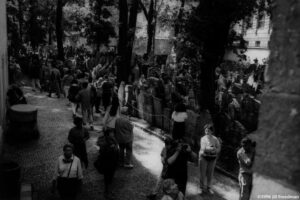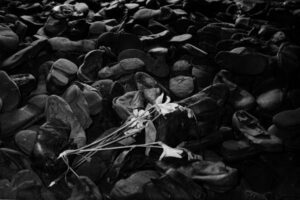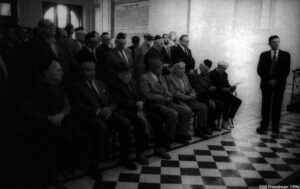Jill Freedman
- 1994

Fellowship Title:
- The Holocaust, 50 Years Later
Fellowship Year:
- 1994

Traces of the Past
Text and photos by Jill Freedman APF fellow Jill Freedman traveled to eastern Europe to document the remnants of Jewish life in Hungary, Poland and Czechoslovakia. These residents of the Jewish home for the aged in Szeged, Hungary listen during a concert of the Israeli Women’s Choir in a synagogue now used for concerts. There are only 400 Jews left in Szeged, most in their 70s and 80s, and there are not enough people to support services, except on Rosh Hashonah and Yom Kippur. More than 3,000 were killed by the Nazis. On the walls of the synagogue vestibule is a poem, in Hebrew and Hungarian, found written on the clothes of a 13-year-old girl. The clothes were lying outside the gas chamber in Birkenau. On April 19, 1941, the Nazi conference on “The final solution of the Jewish problem” was held in Prague, and soon after the first transports of Jews from Nazi-occupied countries left for ghettos and extermination camps. More than 150,000 Jews were sent to Theresienstadt, in Czechoslovakia, from 1941-45. This is

The Reproachful Voices of the Dead
Text and photos by Jill Freedman A child at the Holocaust Memorial in Miami Beach touches the face of a child. At least one and one-half million Jewish children were murdered in the Holocaust. The German and their henchmen were brutal, throwing children out of windows, burying them alive and forcing them into ovens alive. A 12-year-old boy, whose mother had covered him with her body during a massacre in Kovno, Lithuania, in 1941, managed to climb over bodies in a burial pit and escape in darkness. There he was able to see that the earth covering the pit was moving, meaning others were alive, but unable to save themselves. These one and one-half million children are the missing generation of Jews. Every two years, Jewish youths, led by Holocaust survivors, visit the death camps. They burn memorial candles, often leaving messages. Then they travel to Israel, to commemorate the loss and the re-birth of life and hope. Many of the youths are grandchildren of survivors. In the camps was a slogan, “We are the

Survivors
Text and photos by Jill Freedman In the Lublin region of Poland, on November 2, 1943, an operation, given the code name “Harvest Festival” by the Germans, was begun. Its object was the murder of those survivors of the Warsaw ghetto uprising who had been held since April in labor camps at Poniatowa, Trawniki and elsewhere in the Lublin region. In a few days, fifty thousand Jews were shot in ditches behind the gas-chambers of Majdanek, among them more than five thousand Jewish soldiers of the Polish army, who had been held prisoner for the previous four years in the Lipowa Street camp in Lublin. Brought to Majdanek in small groups from Lipowa Street on Nov. 2, the instinct for survival could not be crushed. Led by a former Hebrew teacher, with the surname Szosnik, the Jews broke through the armed guards shouting, “Long live freedom.” Members of the SS, Hitler and the Nazi Party’s paramilitary organization (Schutzstaffel), opened fire. Most of the prisoners were killed. According to Shmuel Krakowski’s “War of the Doomed: Jewish

Judenrein
Text and photos by Jill Freedman The Old New Synagogue in Prague is the oldest surviving synagogue north of the Alps and is barely functioning. It dates from the late 13th century. Most of the religious observant Jews in Prague are in their 70s and 80s. It’s hard for them to get ten men to pray on Sabbath, unless a tourist shows up. Weddings are an occasion. The bride, 21, is from Prague, the groom, 31 from Tel-Aviv. Both work for El Al in Prague. PRAGUE – Rabbi Karol Sidon is the only rabbi in the Czech Republic. His wife, Ruth, is a convert, and so is he, since their mothers were Christian. She didn’t even know of her Jewish grandmother until she was 33 and divorced with two kids of her own. Like most of Czech Jewry, her family was assimilated, so that when her father finally told her, she asked him why he waited so long. Why now? And got the standard reply: “It’s too hard to be a Jew. The cantor sings
